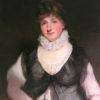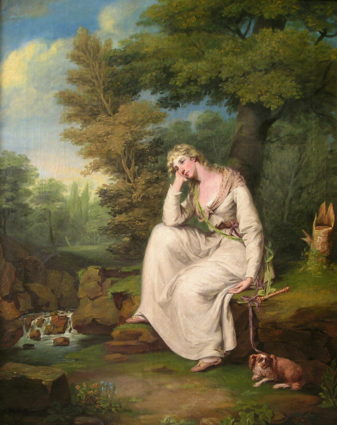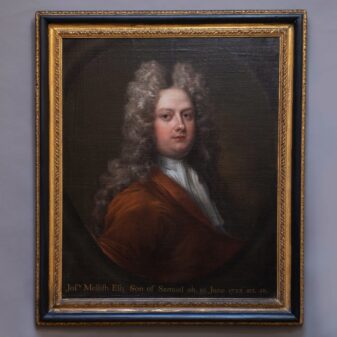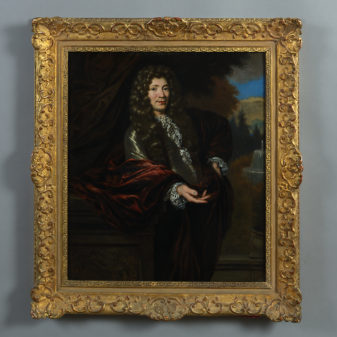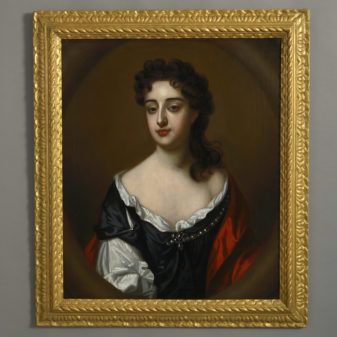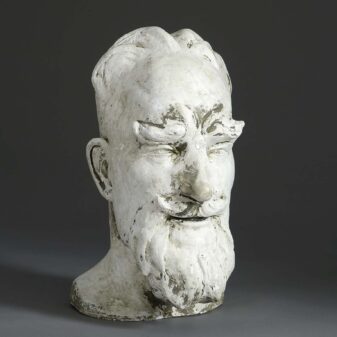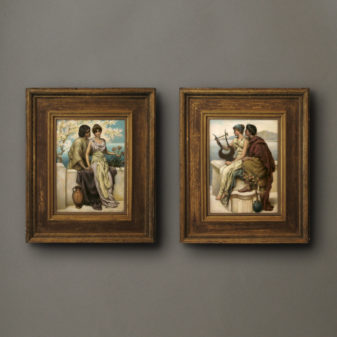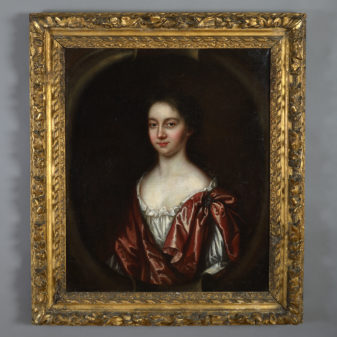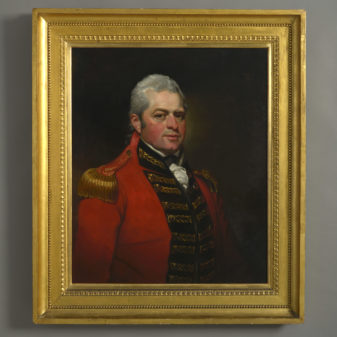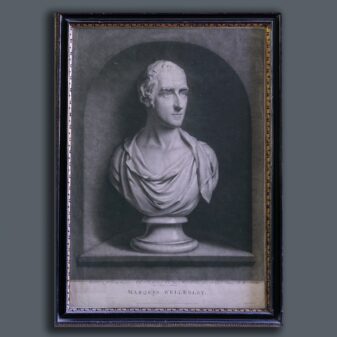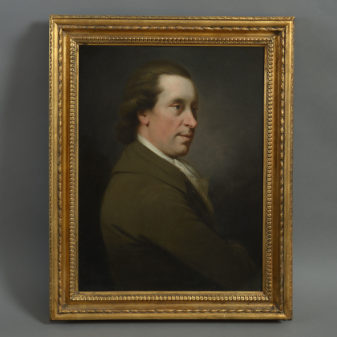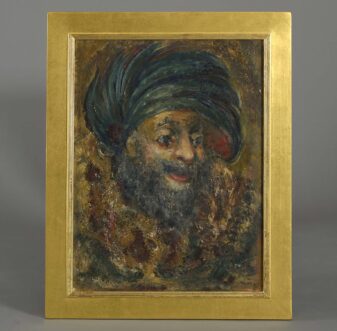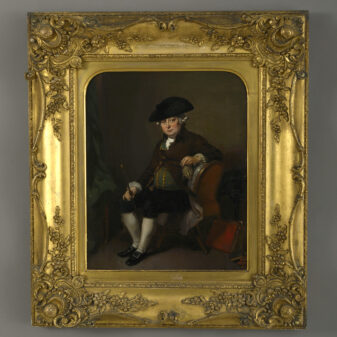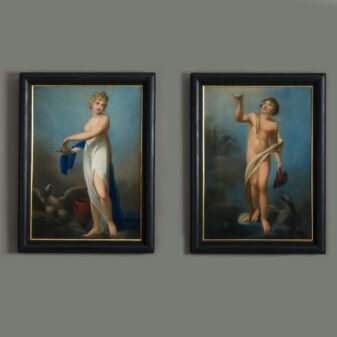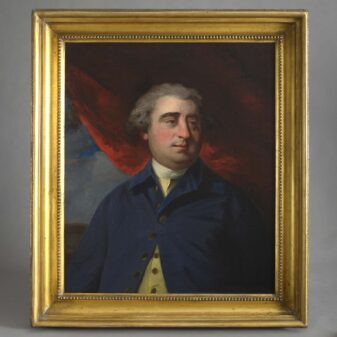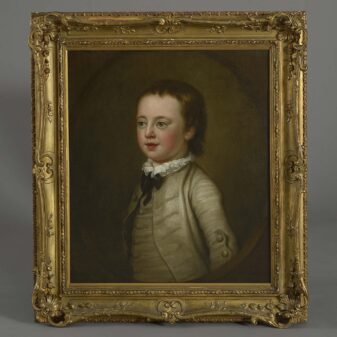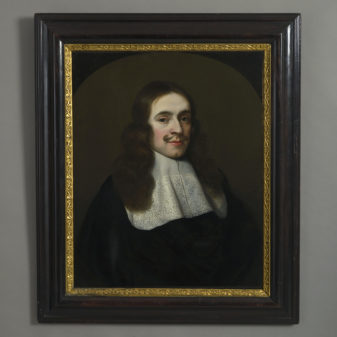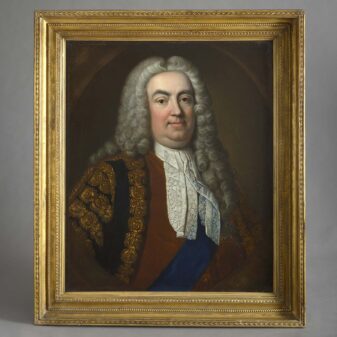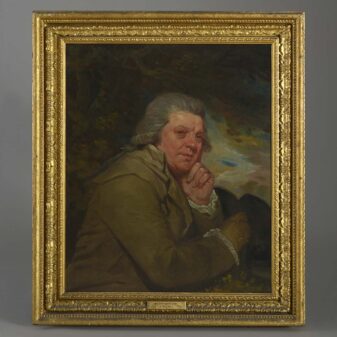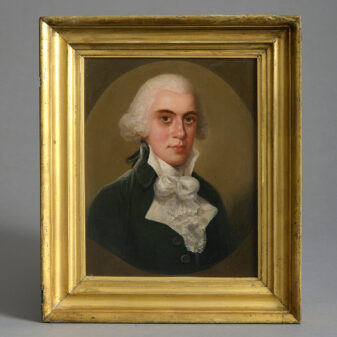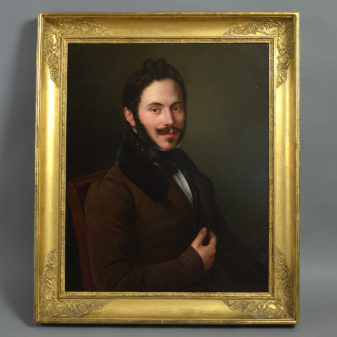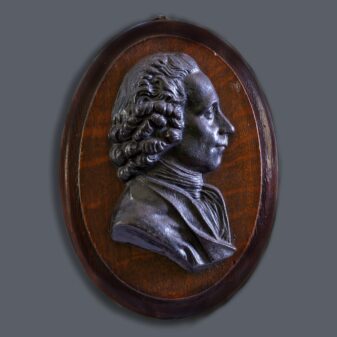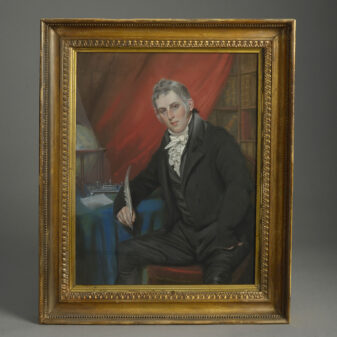Circle of Gilbert Jackson – Portrait of Sir Francis Wenman
£10,000
SOLD
Sir Francis Wenman (1599-1640)
Oil on panel; 30 by 24 ½ in; 76 x 62 cm; held in a 17th century style black & gold wood frame
Provenance: Thornton Hall, Buckinghamshire. Most probably from the sitter and thence by descent to his grand daughter Dozelina, wife of Richard Smith of Padbury, Buckinghamshire; then by descent to their daughter Francis, wife of Thomas Sheppard of Littlecote, Oxfordshire; then by descent to their son Sir Thomas Sheppard of Thornton Hall; then by descent through the Sheppard, Hart and Cavendish families of Thornton Hall; sold by Henry Cavendish c.1904
The sitter here depicted is the posthumous son of Francis Wenman (d.1599) of Caswell House in Oxfordshire and Frances Goodier of Polesworth Hall in Warwickshire. Wenman’s father died in Ireland in late August 1599, three months before his birth at Polesworth, and he became the ward of Sir Allen Apsley, then an Anglo-Irish official. It is not certain how far he maintained his links with his mother, whose second marriage into the Manners family brought her into the circle of the important Duke of Buckingham; nor indeed with his guardian Apsley, who was a relation of the Duke, and became lieutenant of the Tower in 1617. But Wenman was educated at Trinity College, Cambridge (1615) and the Middle Temple (1618) and soon afterwards was knighted, perhaps under the influence of Buckingham. He married Anne, daughter of Sir Samuel Sandys of Ombersley, Worcestershire, in 1628, the same year that he was elected M.P for Oxfordshire.
According to his friend Edward Hyde, the first Earl of Clarendon (1609-1674), Wenman was ‘esteemed in Court’ and ‘equal to the greatest trust and employment, if he had been ambitious of it, or solicitous for it’. He had ‘a competent estate’ in Oxfordshire, including the ancestral seat of his family, and ‘his reputation of wisdom and integrity gave him an interest and credit in that country much above his fortune’. Wenman was also a close friend of Lucius Carey, 2nd Viscount Falkland, and an esteemed member of the Great Tew Circle of Philosophers and Wits. He sat in the Short Parliament, but died shortly after on 26 June 1640. His health had always been poor and is cited by Hyde in explanation of ‘a kind of laziness of mind, which disinclined him to business’. His second son also sat as M.P. for Oxfordshire in 1664 and his grandson, four times Member for Brackley, was to succeed him to Thame Park as head of the Wenman family in 1686.
In 1631, at the time when this portrait was commissioned, Charles I had been on the Throne for six years. In 1628 Wenman became an M.P., the same year the King’s favourite, the Duke of Buckingham, was assassinated. Tensions had been rising between Monarch and Parliament almost since the King ascension, and two parliaments had already been dissolved since 1625. Major disagreements over foreign policy, directed by the Duke of Buckingham, who led catastrophic military expeditions against Spain and the Catholic powers, together with those concerning taxation and religious affairs, saw an embattled and embittered King furiously dismiss his third Parliament in 1629. It would not meet for another eleven years. When it did, Wenman, along with other Royalists, supported Lord Saye & Sele and John Hampden against the King when he tried to once again raise income without the legal support of Parliament in the form of notorious ship money. Two years later the English Civil War began in earnest.
Depicted at the age of thirty-one, this portrait is by an artist whose style closely relates to that of Gilbert Jackson. It is often difficult to attach specific names to many portrait painters working in the provinces during this time, Jackson appearing to be one of the more notable with a few signed works enabling us to draw comparison. Portrayed in the height of fashion for the period, Wenman’s left arm draws a black cloak around his slashed doublet, the elegant gesture setting off his ringed hand and lace cuff to much effect. The highly detailed lace collar, an extremely expensive item of clothing for the period, is equally shown to great effect by the sobriety of dress. Whilst much painterly form can be observed in the face, overall the work looks back to the flat hieratic style of the late Elizabethan Court, with the artist devoting much care to the rendition of surface, colour and texture. The result is a mixture of sophisticated painterly technique allied with a naiveté of drawing which is at once both charming and unselfconscious but noticeably old-fashioned in a Carolean court dominated by the arrival of Anthony Van Dyck.
Given this stylistic approach, it is reasonable to assume that the painter was initially trained in London, perhaps by one of the older generation of portraitists who resided there, who then moved out to work as an itinerant in the provinces – settling in one area to paint the local gentry, where he would have no competition from the better known London painters. Indeed, this portrait owes much compositionally to the work of Cornelius Johnson (1593-1661) and given the subtleties of brushwork which are evident in the face and hair, this implies a method of approach much more skilled than that of an untrained provincial painter.

